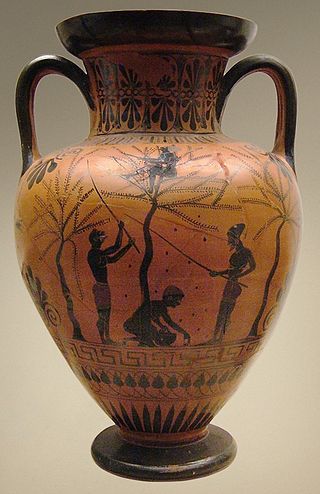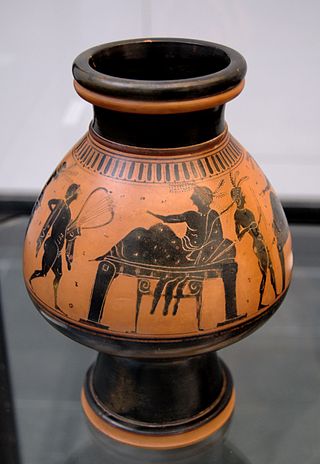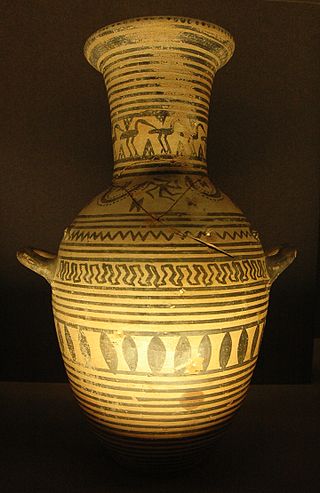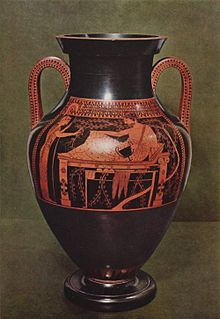
Black-figure pottery painting, also known as the black-figure style or black-figure ceramic, is one of the styles of painting on antique Greek vases. It was especially common between the 7th and 5th centuries BCE, although there are specimens dating in the 2nd century BCE. Stylistically it can be distinguished from the preceding orientalizing period and the subsequent red-figure pottery style.

Exekias was an ancient Greek vase painter and potter who was active in Athens between roughly 545 BC and 530 BC. Exekias worked mainly in the black-figure technique, which involved the painting of scenes using a clay slip that fired to black, with details created through incision. Exekias is regarded by art historians as an artistic visionary whose masterful use of incision and psychologically sensitive compositions mark him as one of the greatest of all Attic vase painters. The Andokides painter and the Lysippides Painter are thought to have been students of Exekias.

Red-figure pottery is a style of ancient Greek pottery in which the background of the pottery is painted black while the figures and details are left in the natural red or orange color of the clay.

Nikosthenes was a potter of Greek black- and red-figure pottery in the time window 550–510 BC. He signed as the potter on over 120 black-figure vases, but only nine red-figure. Most of his vases were painted by someone else, called Painter N. Beazley considers the painting "slovenly and dissolute;" that is, not of high quality. In addition, he is thought to have worked with the painters Anakles, Oltos, Lydos and Epiktetos. Six's technique is believed to have been invented in Nikosthenes' workshop, possibly by Nikosthenes himself, around 530 BC. He is considered transitional between black-figure and red-figure pottery.

The Antimenes Painter was an Attic vase painter of the black-figure style, active between circa 530 and 510 BC.

Psiax was an Attic vase painter of the transitional period between the black-figure and red-figure styles. His works date to circa 525 to 505 BC and comprise about 60 surviving vases, two of which bear his signature. Initially he was allocated the name "Menon Painter" by John Beazley. Only later was it realised that the artist was identical with the painters signing as "Psiax".

Andokides was an ancient Athenian vase painter, active from approximately 530 to 515 B.C. His work is unsigned and his true name unknown. He was identified as a unique artistic personality through stylistic traits found in common among several paintings. This corpus was then attributed by John D. Beazley to the Andokides Painter, a name derived from the potter Andokides, whose signature appears on several of the vases bearing the painter's work. He is often credited with being the originator of the red-figure vase painting technique. To be sure, he is certainly one of the earliest painters to work in the style. In total, fourteen amphorae and two cups are attributed to his hand. Six of the amphorae are "bilingual", meaning they display both red-figure and black-figure scenes.

The pottery of ancient Greece has a long history and the form of Greek vase shapes has had a continuous evolution from Minoan pottery down to the Hellenistic period. As Gisela Richter puts it, the forms of these vases find their "happiest expression" in the 5th and 6th centuries BC, yet it has been possible to date vases thanks to the variation in a form’s shape over time, a fact particularly useful when dating unpainted or plain black-gloss ware.

The Belly Amphora in the Staatliche Antikensammlungen at Munich is one of the most famous works by the Andokides Painter. The vase measures 53.5 cm high and 22.5 cm in diameter. It dates to between 520 and 510 BC and was discovered at Vulci. It was acquired by Martin von Wagner, an agent of Ludwig I of Bavaria.

The Tyrrhenian amphora is a specific shape of Attic black-figure neck amphora. Tyrrhenian amphorae were only produced during a short period, about 565 to 550 BC. They are ovoid in shape and bear striking decorations. The handle is usually decorated with a lotus-palmette cross or vegetal tendrils. It always terminates in a red-painted ridge. The vase body is painted with several friezes. The uppermost of these, on the shoulder, is usually especially notable. It often contains mythological scenes, but the first erotic motifs in Attic vase painting also occur here. Unique motifs include the sacrifice of Polyxena. Often, the figures are explained by added inscriptions. The other friezes, usually two to three in number, are often decorated with animals. At times, a frieze is replaced with a vegetal band.

Eye-cup is the term describing a specific cup type in ancient Greek pottery, distinguished by pairs of eyes painted on the external surface.

A Nikosthenic amphora is a type of Attic vase invented in the late 6th century BC by the potter Nikosthenes, aimed specifically for export to Etruria. Inspired by Etruscan Bucchero types, it is the characteristic product of the Nikosthenes-Pamphaios workshop.

The Leagros Group was a group of Attic black-figure vase painters active during the last two decades of the 6th century BC. The name given to the group by modern scholars is a conventional one, derived from a series of name vases.
The Princeton Painter was an Attic black-figure vase painter, active in the third quarter of the sixth century BC, just after Group E. His real name is not known.

The Euphiletos Painter was an Attic black-figure vase painter active in the second half of the sixth century BC.

The Lysippides Painter was an Attic vase painter in the black-figure style. He was active around 530 to 510 BC. His conventional name comes from a kalos inscription on a vase in the British Museum attributed to him; his real name is not known.

Boeotian vase painting was a regional style of ancient Greek vase painting. Since the Geometric period, and up to the 4th century BC, the region of Boeotia produced vases with ornamental and figural painted decoration, usually of lesser quality than the vase paintings from other areas.

A Caeretan hydria is a type of ancient Greek painted vase, belonging to the black-figure style.

The Pontic Group is a sub-style of Etruscan black-figure vase painting.

The bilingual eye-cup by the Andokides painter in the Museo Archeologico Regionale, Palermo, is a prime example of the transition from black-figure vase painting to the red-figure style in the late 6th century to early 5th century BC that commonly resulted in "bilingual" vases, using both styles. The Andokides painter created the red-figure style of pottery as we know it today during his working years from 530–515 BC. Starting around 530 BC the Andokides painter produced red-figure amphorae and a bilingual kylix. Fewer than 20 vases survive by the Andokides painter but they span 30-40 years of his career, allowing historians to trace the development of his painting styles. One of the earliest mentions of the Andokides painter was on a black-figure hydria by Timagoras around 550 BC, when the Andokides painter must have been an apprentice.


















